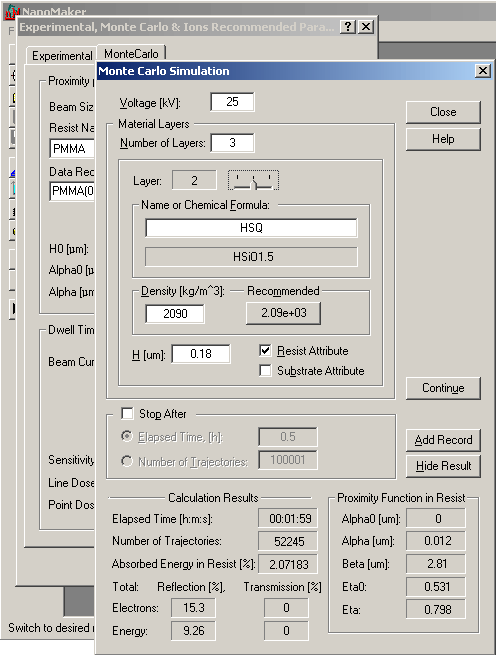The optional module to calculate proximity function by Monte-Carlo method for multilayered substrates is created
May 25, 2009
 The optional module to calculate proximity function for multilayered substrates
is created. The calculated distribution of the absorbed energy (dose) in a resist
is fitted by two Gaussians which parameters vary with depth. A new parameter
-
The optional module to calculate proximity function for multilayered substrates
is created. The calculated distribution of the absorbed energy (dose) in a resist
is fitted by two Gaussians which parameters vary with depth. A new parameter
-  0,
added to proximity function, allows to consider dose changes with resist depth.
The data calculated by Monte-Carlo method, along with former experimental data,
are used now as Recommended Parameters at exposure, proximity effect correction
and simulation of resist development procedures. 0,
added to proximity function, allows to consider dose changes with resist depth.
The data calculated by Monte-Carlo method, along with former experimental data,
are used now as Recommended Parameters at exposure, proximity effect correction
and simulation of resist development procedures.
The dialog is used to set initial
parameters and to run software for calculation of absorbed energy distribution
after scattering of electrons in multi-layer target. Incident electron beam
falls down (perpendicular to XY plane of layers) and has zero size (diameter).
Numbering of layers starts on surface from a point of beam falling and proceeds
deep into target. Topmost layer has number 1, last deepest layer has maximal
number. Up to 20 layers can be introduced.
Monte Carlo method is used for simulation of a large number of electron trajectories.
The algorithm uses Rutherford scattering at a screened nucleus and continuous-slowing-down
approximation for energy loss along an electron trajectory [1]. Lost energy
is accumulated in cells of a calculation grid. The grid has cylindrical symmetry
in XY plane with center at axis of electron beam and grid is irregular along
radius and Z direction. This speeds up calculation allowing 50000 trajectories
per 2 min (Voltage=25 kV; PMMA resist H=0.5  m;
Si substrate) on Intel Core Duo CPU. Such quantity of trajectories usually is
sufficient for proximity parameters calculation. m;
Si substrate) on Intel Core Duo CPU. Such quantity of trajectories usually is
sufficient for proximity parameters calculation.
One layer in the target should be marked as resist one. Energy distribution in the layer is the sought proximity function I(x,y,z) for proximity effect correction and for resist development simulation.

Where  = 3.1415…. Energy distribution accumulated in the calculation grid is
fit by the formula using linear approximation for
= 3.1415…. Energy distribution accumulated in the calculation grid is
fit by the formula using linear approximation for  (z)
( (z)
( 0= 0= (H)
on top of resist surface, (H)
on top of resist surface,  - on bottom of resist surface).
- on bottom of resist surface).  2(z)= 2(z)=
 02+( 02+(
 2- 2- 02)*(
1-z/H )3, where z- distance from resist bottom. Five parameters: 02)*(
1-z/H )3, where z- distance from resist bottom. Five parameters:
 0, 0,
 , ,
 , ,
 0, 0,
 define proximity function for Proximity Simulation. Three parameters:
define proximity function for Proximity Simulation. Three parameters:  , ,
 , ,
 set proximity function for Proximity Correction.
set proximity function for Proximity Correction.
[1] L. Reimer "Scanning Electron Microscopy. Physics of Image Formation and
Microanalysis" Second Edition Springer Series in Optical Sciences Vol. 45, 1998
|


 The optional module to calculate proximity function for multilayered substrates
is created. The calculated distribution of the absorbed energy (dose) in a resist
is fitted by two Gaussians which parameters vary with depth. A new parameter
-
The optional module to calculate proximity function for multilayered substrates
is created. The calculated distribution of the absorbed energy (dose) in a resist
is fitted by two Gaussians which parameters vary with depth. A new parameter
- 